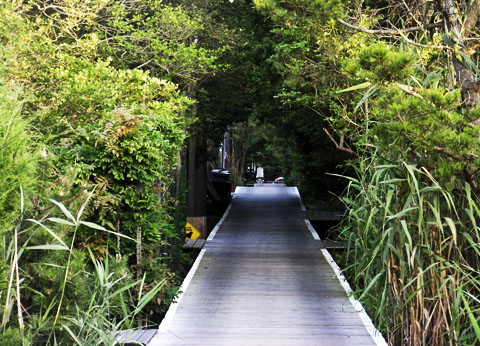
|
||
|
Issue 67 |
|
6 September 2012 |
The BooksCarfree Cities and Carfree Design Manual are widely available in Europe and North America.World Carfree NetworkCarfree.com actively supports World Carfree Network (WCN). The main news from the network follows. The network stands at the point of some degree of renewal and rebirth and could use your help if you have time available.World Carfree NewsWorld Carfree News is now available in Czech, English, French, German, Italian, Portuguese, and Spanish. It's published monthly and is a great way to keep abreast of important developments in the carfree cities network.
|
|
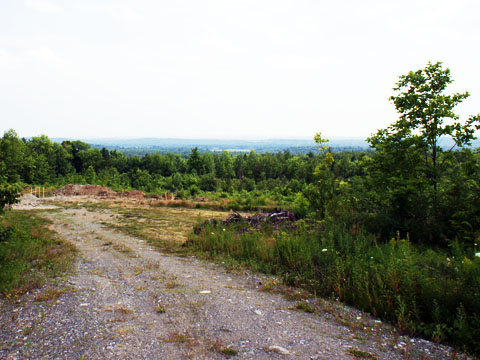 A typical view of the rolling hills in southern Piscataquis County ©2012 J.Crawford View Random photographs of Piscataquis County on Flickr
Feature ArticlePiscataquis Village (Re)visitedBy J.H. CrawfordIn the last issue, Tracy Gayton provided an introduction to the Piscataquis Village Project. This July, Tracy was kind enough to host me at his digs in Dover-Foxcroft, Maine, which is at the center of the region being considered for the new carfree village.During the course of a busy week (that did include time for the local pastime, drinking good beer), we explored all the larger towns in the region (yes, by car. . .) and talked to dozens of local folks, including people on the planning boards. There is a good deal of local support for the project.
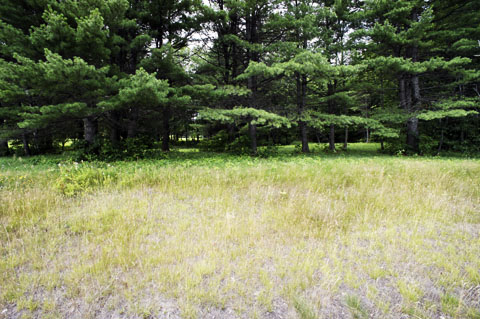 Central Maine: rural and largely wooded ©2012 J.Crawford The region under consideration for the project is the southern quarter of Piscataquis County and occupies an area about 30 miles by 30 miles, extending from the towns of Greenville and Brownville in the north to Wellington and Orneville in the south. There are a handful of towns in the area, none as large as Dover-Foxcroft, the county seat, with a population of about 4,500. Several of the towns have business parks, but they have been slow to attract tenants. Some might possibly serve as a site for Piscataquis Village, although legal restrictions may preclude our form of development. There are many large parcels of land available in the area, most not far from the Piscataquis River. The region's economy continues to be largely based on manufacturing and forest products, although the virgin forest was all cut more than a century ago. There is a considerable tourism industry that draws visitors year-round. Land is generally quite cheap. Despite the rural nature of the county, there are a number of rail rights-of-way in the project region. Most are abandoned, but two still see considerable use. Abandoned rights-of-way pass through many potential project sites. An eventual resumption of passenger service is possible.
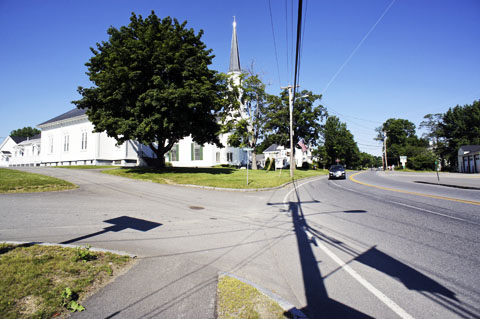 Dover-Foxcroft, a fairly typical New England town ©2012 J.Crawford The land is highly suitable for our purposes. It floods only near the river and streams, and there is enough relief to get above the flood plain without going far from the river. It's a pretty area in a quiet way, with occasional views to the substantial mountains many miles to the north. The economy has been depressed for many years, but people seem to make do through a mix of ingenuity and hard work. People are friendly in the usual Maine fashion. Efforts to improve the cultural offerings have succeeded.
 The former Moosehead Furniture factory in Dover-Foxcroft ©2012 J.Crawford Not so long ago there were some large wood and textile mills and factories, originally powered by the river they abut, but many have closed. Arnold Development Group has proposed an ambitious plan to redevelop the largest facility in the area, the former Moosehead Furniture factory in downtown Dover-Foxcroft.
 Busy streets in quiet Dover-Foxcroft ©2012 J.Crawford Central Dover-Foxcroft has about 2500 residents in a fairly compact area, with a further 2000 people living in the township. Quite a few migrants from Boston and New York have settled here permanently. It is a service center for the region, with the county court house and a hospital. Dover-Foxcroft is less than an hour's drive to Bangor's international airport. The town has many fine older houses and some pleasant walking, but it does stand at the junction of several important highways, so the downtown is subject to traffic noise including heavy trucks. The local industrial park is located on a low hill a few minute's walk from downtown. It is a potential site for Piscataquis Village, but the use restrictions under which it was established may preclude our intended use.
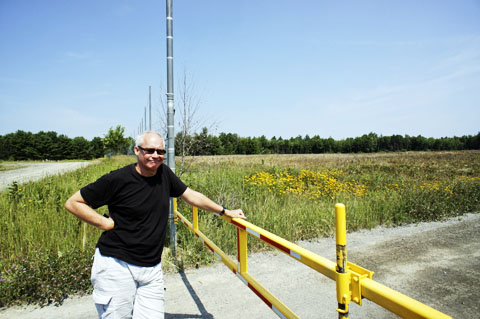 Tracy Gayton, mover and shaker ©2012 J.Crawford Tracy Gayton is a force to be reckoned with. He moved to Maine in the early 1980s after hiking the entire length of the Appalachian Trail (which ends at Mt. Katahdin in central Piscataquis County). Later, he was a vice president and regional manager for one of the state's largest banks for nearly twenty years and seems to know everybody. He is tireless, energetic, and totally committed to seeing Piscataquis Village actually built. As of press time, he had collected pledges totaling $390,000 from 34 contingent investors. This is a fifth of the amount needed. An increasing percentage of these pledges is coming from outside Maine.
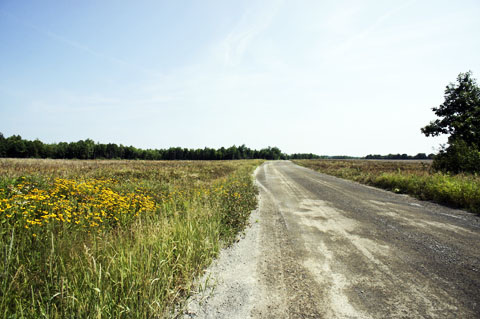 The industrial park site in Milo ©2012 J.Crawford At the end of our week together, Tracy and I went to Portland, where we gave a talk to about twenty people interested in the project. All in all, a very productive week. As I noted in the last issue, I have become one of the contingent investors in the project and would build the Reference Building more or less as shown in Carfree Design Manual if the project goes ahead. I think Piscataquis Village is currently the most viable candidate to build the first US carfree district. I encourage everyone with an interest in carfree cities to consider joining forces with me, Tracy, and the others who have committed to the project. Investment pledges can be made in blocks of $10,000. For more information, see the Piscataquis Village web site (especially the "Six Key Design Elements") and the Facebook page. Oh, and if you pledge, you might end up making a nice return on your investment...
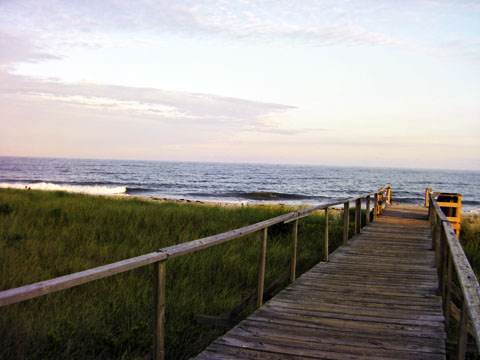 Fire Island at Cherry Grove ©2012 J.Crawford
Feature ArticleCherry Grove on Fire Island, NYBy J.H. CrawfordFire Island is a long, narrow barrier island south of Long Island, separated from it by a broad sound. It's a typical barrier island - mostly low and sandy. The dunes have been left in place to protect against storms.Cherry Grove is a rich community with a few thousand summer residents, most of them LGBT, who come out from New York City on the weekends and for vacation. I spent three nights there at the end of July and found it a relaxing and delightful place. It's very quiet, and the beach is beautiful. I suppose that this is the largest truly carfree community in the USA.
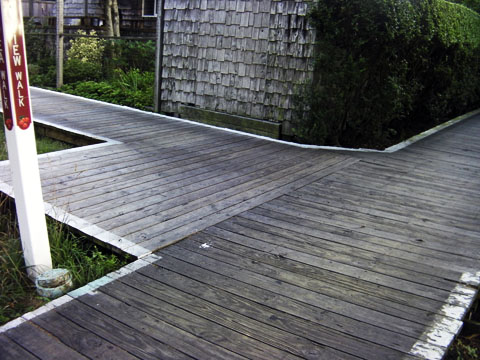 Boardwalk in Cherry Grove (note the widening at intersections) ©2012 J.Crawford The entire island is car-lite, but the community of Cherry Grove is entirely carfree for the one reason that always works: you couldn't drive a car there if you wanted to. The streets are paved with wood, and they are only five feet (1.5 meters) wide. You may see a service truck driving up and down the beach itself.
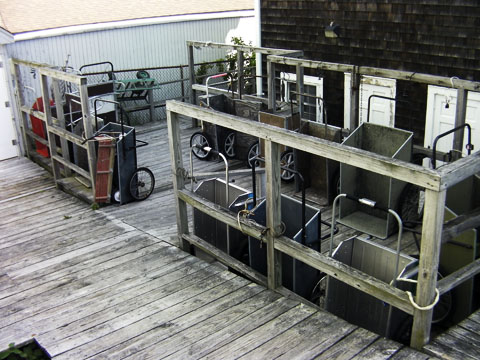 Handcart storage near the dock ©2012 J.Crawford Cherry Grove offers some useful lessons in the logistics of carfree communities. People walk everywhere (there are not even any bicycles). Handcarts are used to move things from the ferry landing to their houses and businesses, none of which are as much as a mile from the dock. The businesses, in fact, are all clustered near the dock. Handcarts are available right at the landing.
 Three-wheeled service cart ©2012 J.Crawford Electric service carts are used to move things that are too heavy for easy handcart use. There are quite a few of them, but they are pretty slow and very quiet.
 Another electric cart ©2012 J.Crawford The walkways are narrow enough that it's a bit tricky to pilot one of these service carts, and if you get it wrong, you fall a foot or so off the boardwalk, which must be tedious when it happens. To ease the chore, the walkways are broadened at intersections.
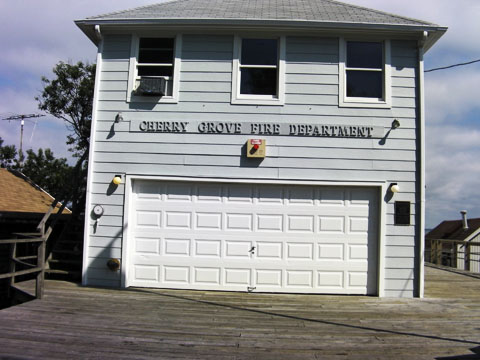 Cherry Grove Fire Department ©2012 J.Crawford How, you may ask, are fire protection services provided? This is a highly flammable community. Winds here are often strong, and everything is built out of wood, including the fire department itself.
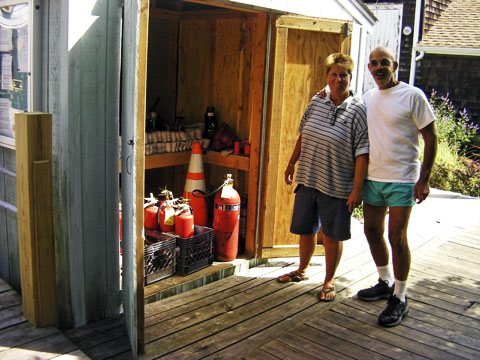 Volunteer firefighters Bobbie Green and Tim Webster in front of a hose house ©2012 J.Crawford There have been some bad fires, but they have been contained by the all-volunteer fire department.
 Fire service hose house and adjacent hydrant ©2012 J.Crawford The key to fire protection is a series of fire service hose houses located within a block of every building. Adjacent to each hose house is a fire hydrant.
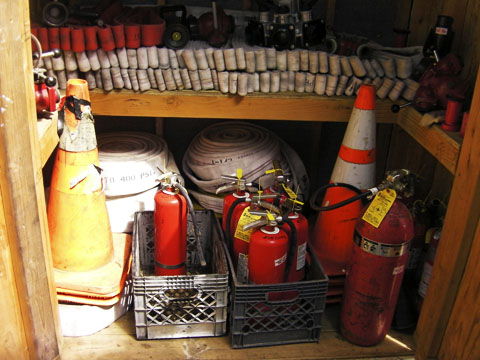 Contents of a fire service hose house ©2012 J.Crawford The first fire-person (many are women) on the scene opens the hose house (which is never locked) and carries basic rescue equipment to the scene of the fire.
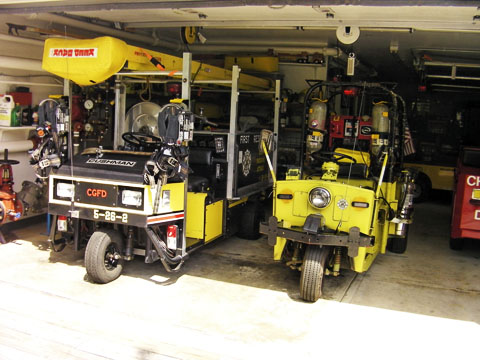 Two fire engines, Cherry Grove style ©2012 J.Crawford The initial responder is followed by firefighters on the fire trucks, which are built on the same three-wheeled golf-cart style chassis as other service vehicles. One truck carries ladders, which need not be long because no building exceeds three stories. One truck is a pumper, which can boost pressure from the hydrant. The usual breathing gear is carried on the trucks, and every member of the department has his or her own safety suit. Fire fighting proceeds in the usual manner once people and equipment are on the scene. What lessons should we learn from this? First, of course, is that all of the issues raised against carfree districts can be resolved. Second is that carfree areas are cheaper to build (lower pavement costs, smaller rights-of-way) and are worth a lot more money in the market. Of course, this leads to the question of whether or not any developers are listening. There is money to be made here. My thanks to the people of Cherry Grove and especially to Bobbie Green for taking the time to explain the workings of the fire department and various other things.
 View of Basse Ville and the St. Lawrence River from Haute Ville, Quebec City ©2012 J.Crawford
Feature ArticleQuebec City: Paradise in North AmericaBy J.H. CrawfordI had been in Quebec City for a day before I discovered the carfree Petit Champlain section of Basse Ville (the Lower City). My hotel was in Basse Ville, just a five-minute walk from the carfree area, and I found it quite by chance. Quebec City is a major tourist destination for many good reasons, not least of which is the excellent food and vibrant French culture. However, a disproportionate number of tourists spend their time in the carfree Petit Champlain section.
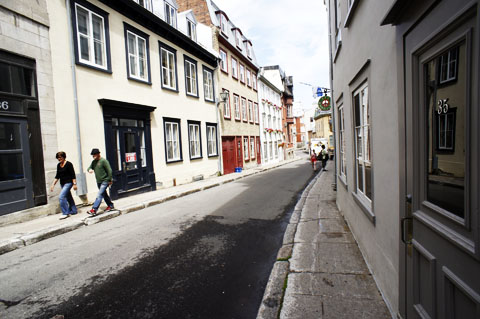 "Optically carfree" street in Haute Ville ©2012 J.Crawford Until I discovered Petit Champlain, I had been a bit disappointed, as most of the rest of the city, built on the ramparts above, is not carfree even though some of it is "optically carfree," to use Markus Heller's term for it - no cars visible, but cars do use the streets from time to time. Mind you, the upper town is delightful, at least by North American standards, but the carfree Petit Champlain section of Basse Ville is perhaps the nicest urban area on the continent.
 Street map of part of Petit Champlain The carfree district continues below and to the right of the area shown. This is a pretty large area, only about half of which is shown on the map above. It is 400 meters (1300 feet) on the long axis and 100 meters (330 feet) on the short axis. It takes more than five minutes to walk across it.
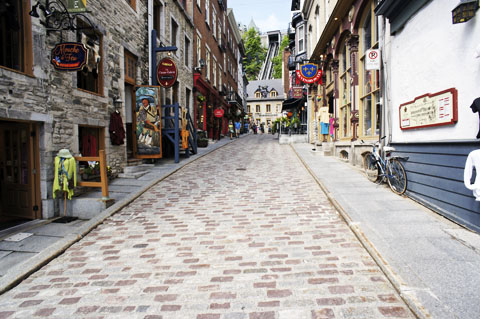 Rue Sous-le-fort in Petit Champlain ©2012 J.Crawford The principal access from the Haute Ville is by a funicular running up the steep hillside (visible in the distance), although there are many other routes. Inevitably, it is surrounded by ordinary streets on the other three sides, but these are distant enough and sufficiently well separated that they do not impinge much on the carfree nature of Petit Champlain.
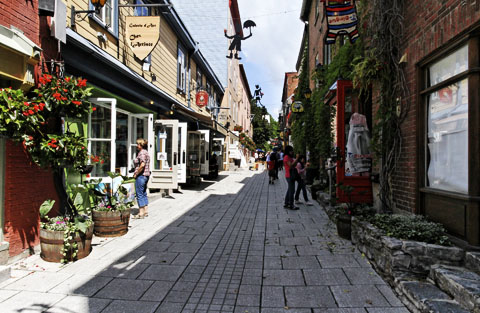 Rue du Petit-Champlain ©2012 Robin Bassett The Rue du Petit-Champlain is the longest street in the district, although not the grandest space. It is here that the restaurants are mainly to be found, and one can certainly eat well here, if not cheaply.
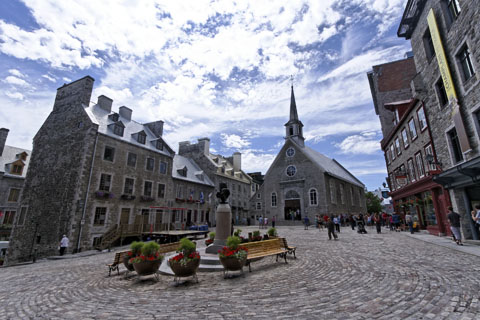 Place Royale ©2012 Robin Bassett Place Royale is the grandest space in Petit Champlain. It is about 23 by 32 meters (75 by 105 feet) and feels like a large space. (The wide-angle perspective of the photograph makes it appear larger than it is.) All of the guided tours stop here for a long discussion of Samuel de Champlain and his exploits, real and imagined, in French North America.
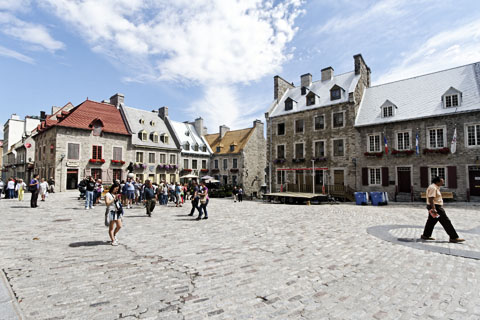 Another view of Place Royale ©2012 Robin Bassett There is one outdoor cafe, just visible in the photograph above, and the square really could use another one. The area is almost perfect, a little too perfect, in fact. I began to suspect after a day or so that it was a reconstruction. This was borne out by a discussion with the staff of the adjacent museum. The whole area had fallen into decay and even ruin by 1970, and it was subsequently completely rebuilt. I must say, however, that the reconstruction really has the feel of a very old space, and it seems to have been done true to the spirit of the original construction. Only by the lack of sagging roofs and walls a bit out of plumb can one really discern that the buildings are not very old. This is proof, if any were needed, that we can still build in the old manner when we choose to. This entire area can be taken as indicative of the kinds of carfree districts I find ideal. The scale is gorgeous, the detailing of the buildings is excellent yet restrained, and the lack of perfectly rectangular blocks and squares is, to my eye, delightful. Here we have another example of a practical carfree area that is a true cash cow for the city lucky enough to possess it. I say again, there is money to be made in carfree development.
Feature ArticleReflections on Freedom-Loving Americans and CarsBy Debra EfroymsonIn a recent edition of Carfree Times, J.H. Crawford reviewed a book that explodes the myth of the car as a source of freedom. Regarding the car as the default mode of transport not only wreaks all sorts of environmental damage and has led to the obesity crisis, not to mention the misery of traffic congestion, but means that people become their own unpaid chauffeurs. Driving on an empty road may be enjoyable to some; some also enjoy tinkering with their vehicle to keep it running properly. For the rest of us, driving means being stuck in traffic, while maintenance and repairs are troublesome as well as expensive.Of course the myth of cars as freedom must have some basis beyond the all-pervasive and powerful advertising, not only in terms of direct ads for cars but the way cars are portrayed in other ads and in movies, newspapers, and other media. Yes, in a car one may have the freedom of door-to-door transport; on the other hand, there is less flexibility because you must park the car somewhere, and unless you're using a shared car, pick it back up in the same spot. (Yes, that's also true of a bicycle, but they are far easier to move around and cheaper to park.) Without a car, I can avail myself of a range of modes which can mean more, not less, flexibility. A few days ago in Colombo I took a taxi to a meeting (traveling on non-air conditioned buses in the tropics is, I confess, not pleasant at rush hour), walked from my meeting to my next destination, took a tuk-tuk from there to lunch, then took the bus home. It cost about $8 to get into the city and 15 cents to take the bus back home. The freedom to sit in a traffic jam is not a particularly valuable one; quality public transit, or even good paths for walking and cycling, can get us places faster. And compared to sitting in a car, the recreational and other possibilities while on public transit seem endless: eavesdropping, chatting with a stranger, reading a book, messaging. Walking and cycling also of course allow the enjoyment of one's surroundings and the pleasures of a sociable trip. And then, call me quirky, but when I did drive, I never liked the fact that I could easily kill someone while behind the wheel of a car. (Free to be homicidal??) In no other daily activity do I have the remotest possibility of causing someone else's death, however hard I might try or however devoutly I might wish it. It just isn't that easy with bare hands or minor implements to do somebody in. But all it takes is a small miscalculation, a child running into the street after a ball, an impatient pedestrian rushing across the street. The issue is not one of legal liability; it's the knowledge, for the rest of my life, that I have, however unintentionally, killed someone. That's not a responsibility I want, and it angers me that it is commonly assumed that I should be willing to take it on. But I think the argument that most gets me is the idea that I, as an individual, am expected to be delighted at having the freedom to spend thousands of dollars to purchase a private vehicle, then spend large amounts on insurance, fuel, repairs, and (sometimes) parking, while the government gives me. . . roads. And, too often, free parking. If the government is going to spend billions of dollars to facilitate my mobility, why not do it in a way that doesn't require such a large contribution on my part of both time and money? If the government instead were to provide good infrastructure for walking and cycling, as well as high quality public transit, I would spend a fraction on moving about of what I would do if I owned a car. I wouldn't have to worry about maintenance and repair, or the nasty smelly business of getting fuel. Admittedly I am as ignorant of bicycle as of automobile maintenance and repair. Not a problem when I lived in Hanoi: at every street corner there was a man with a pump, and many corners also had a bicycle repairman. Safe parking facilities were available throughout the city for a nominal charge. All I had to do was ride, and while the charges for maintaining my bicycle were minimal, they went straight to small independent local businessmen, none of it being wasted on fuel or expensive parts. Independent mobility definitely felt like freedom there. To the best of my knowledge, public schools in the US are free. In all industrialized countries other than the US, the government ensures nearly free access to health care as well. Other than Texan politicians, virtually nobody calls the US government socialist for providing free education. If we ever got a decent government health system, almost nobody would complain about that either. Inhabitants of many European countries are used to the idea that public transit is convenient and reliable, and that they can walk and cycle easily and safely in cities. It's about time that Americans demand that the US government provide us with better transport options, ones that don't demand such high spending on the part of citizens who often can't afford it. That is, transport should, like education, social security, and (ahem) health care, be part of the package that people assume the government will provide. But of course the word "freedom" is often used in funny ways in the US. Even if the government were to provide quality bike lanes, where is the coercion? Nobody is forcing people to use them. But when the only transport options the government provides are of so poor quality that people are forced to drive, then our freedom is limited. A recent article in The Economist blog, "Why walking leads to one world government" about an upcoming ballot initiative in the state of Georgia to fund transport options, leads to the typical storm of heated responses. One person claims, "Walking or biking is not a viable transportation alternative for the average struggling person. . . why should us folks pay for your healthy recreational workouts?" To which, fortunately, another points out that driving is even less of an option (while omitting to point out that non-car users are all paying for roads and "free" parking). Having worked for many years in tobacco control, I recognize the passion in people's pro-car arguments. Perhaps until recently, people said the same thing about cigarettes. How can you ban advertising and make public places smoke-free? That limits our freedom! Who wants to live under a nanny state? Who are these pro-health Nazis (yes, one does hear that unbelievable term) foisting their preferences on the rest of us? Omitting, of course, the minor detail that otherwise the cigarette companies and smokers are foisting their ads and smoke on the rest of us. I would respect people's "right" to drive more if that "right" did not interfere with my own right to get about safely and conveniently without a car. This is by no means an easy issue. Because the US has devoted so many resources to building infrastructure for cars, and because some enormously wealthy and powerful companies benefit from our dependence on cars, change will not come easily. And there are, without a doubt, personal benefits to driving and inconveniences to getting about by other modes. Those inconveniences are easily surmountable, and the challenges and expenses of creating and maintaining a high quality, carfree transport system are far less than those of creating and maintaining a car-based system. Nonetheless, even as the tide is turning, vehement vocal opposition to doing things another way is likely to continue, and if people can't find a logical argument, they'll happily ditch logic to defend the status quo. I'm all for the freedom to shout at each other about what kinds of transport systems and what kinds of cities we want. What I object to is the belief that freedom means cutting off precisely those options that would benefit people's health, the environment, the economy, and quality of life. And one might be forgiven for believing that it is more important to guard the basic freedoms - those of walking, cycling, and using high quality public transit - before worrying about whether people have the "freedom" to drive themselves everywhere.
Debra Efroymson is Regional Director for HealthBridge,
a Canadian NGO which in addition to its more traditional public health programs also works on Liveable Cities. Debra has lived and worked for 16 years in Asia and has spoken and written extensively on issues of non-motorized transport, liveable cities, and carfree urbanism.
News BitsThe links below will open in a new browser window (crtl + left-click to open in a new tab instead):
 Mayor gives up parking space ©2012 Joseph Wetmore
"Svante Myrick, Ithaca's Youngest-Ever Mayor, Converts Personal Parking Space Into Public Park"
"The Climate Fixers: Is there a technological solution to global warming?"
"Hundred-Year Forecast: Drought"
"Germany plans massive wind power grid"
"Money Is All Thatís Green in Biodiesel"
"Sustainability is More Than Gizmo Green"
"Road Traffic 'Single Biggest Source of Fatality' for Young People Worldwide"
"Just How Bad Is Noise Pollution for Our Health?"
"Global weight gain more damaging than rising numbers"
"Kids Who Get Driven Everywhere Don't Know Where They're Going"
"Whose Roads? [PDF!] Evaluating Bicyclists' and Pedestrians' Right to Use Public Roadways"
"How to Make Transit (and Biking and Walking) Sexy"
"Navigation or Legibility - Which Way?"
"Transportation Prescription for
Healthy Cities [PDF!]"
"Now Coveted: A Walkable, Convenient Place"
"Science for Designers: Scaling and Fractals"
 Arctic Sea Ice Extent The yellow line ends at 2 September 2012. Who knows where it goes next? from The Cryosphere Today Editorial: Ice and Your FutureThis summer, Arctic sea ice reached a level just half of what was once considered normal. There are many yardsticks for Arctic ice, and this year essentially all of them saw new lows reached weeks before the end of the melt season, around September 21st. In fact, in no year since 2007 has the summer ice minimum been as high as it was in every summer before that year (since satellite observations began in 1979). This is really quite extraordinary.The winter ice extent as of March 2012 was normal, but melting since then has been exceptionally rapid. This is due in part to the accumulated "ice debt" of the past several years: most of what ought to be thick, multi-year ice is now thin, single-year ice that melts quite readily. The physical processes that underlie sea ice formation and melting are complex. The influence of polar ice is felt thousands of miles south of the pole, and it now appears that the weather has become more "sticky" because the jet stream makes taller loops that tend to stay in place for long periods. The jet stream change caused the extended droughts of recent years, the extreme summer heat seen for weeks across a huge area of the United States, the soggy early summers that have plagued northern Europe for a couple of years, and so forth. The question is what we are going to do about it. There are the techno-fixers (see "The Climate Fixers," above), and there are still plenty of deniers. I think most people have a gut feeling that "something's wrong with the weather" but have no idea what to do about it. This is not, however, a time for despair. While we may not be able to avert significant and largely adverse climate change, there are many things we can do in the near term to considerably reduce the emission of greenhouse gases, and there are other things we can do in the longer term to take a further large chunk out of emissions. Time is short, however, and prompt action is essential. The solutions are all pretty well known by now, and of course include carfree cities. Many approaches actually improve the quality of life, while sometimes making it a little less convenient. Most approaches actually save money and create jobs. So what are we waiting for? My own feeling is that people will not be motivated to seek change until some climate disaster strikes so hard that people are jolted out of their stupor. I fear that we won't have long to wait. This year's Arctic ice melt got major play in many newspapers, but I'm afraid that it's not dramatic enough, even as scary as it is. What is it going to take? How much longer are we going to wait? What are you going to tell your grandchildren about your role in all this?
Back to Carfree.com
E-mail
|
